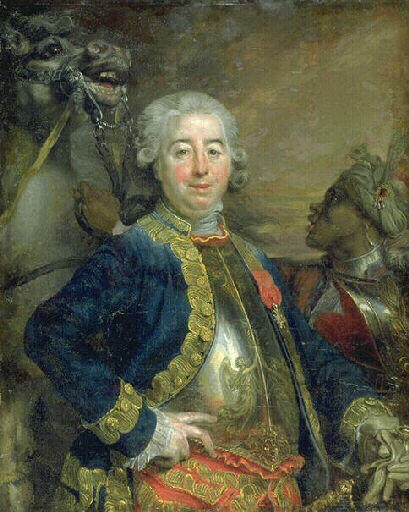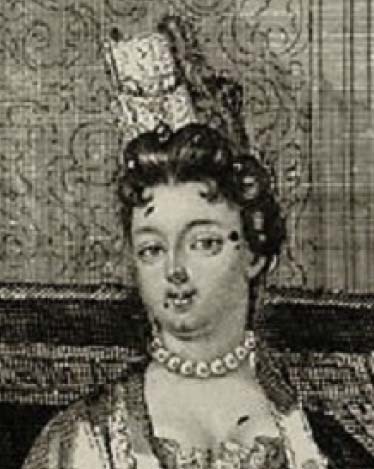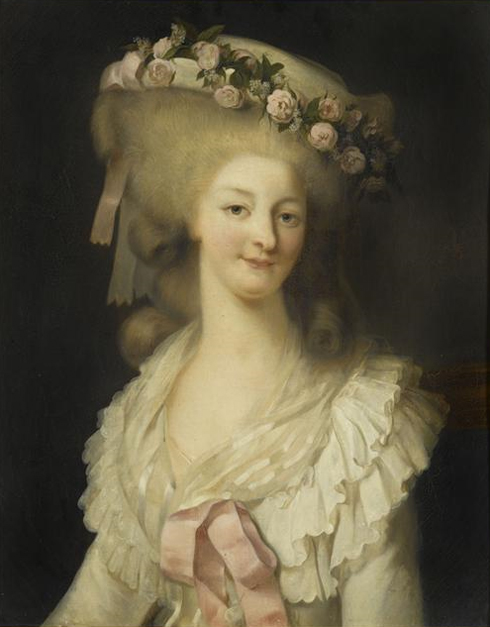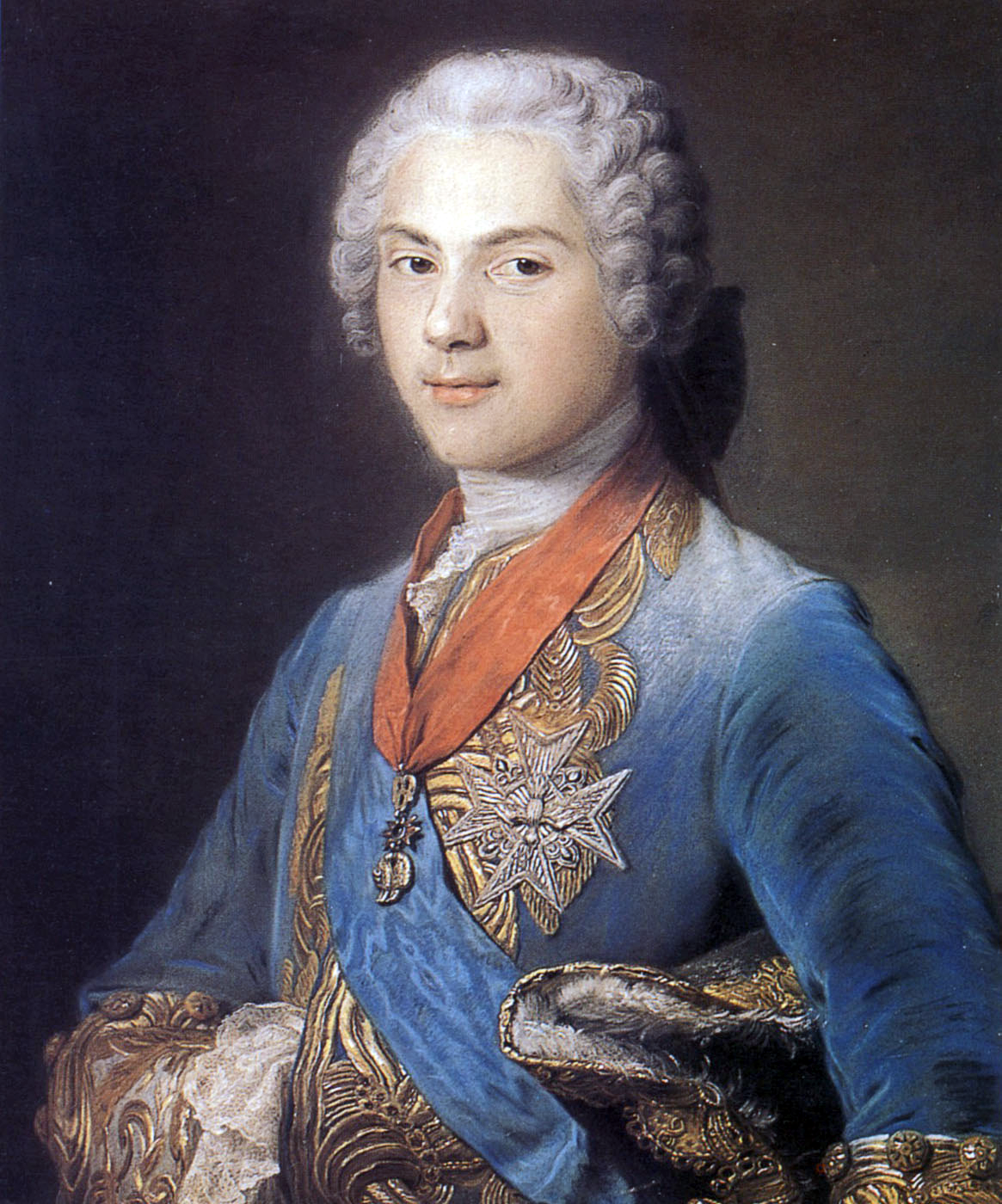Originating from Guyenne, the House of Durfort was condensed into four branches by the time of Louis XIV: the first was headed by the Duc de Duras, the second by the Duc de Lorges, the third by the Duc de Civrac and the final by the Comte de Durfort. The family is quite large, so the focus is primarily on the main "players".
The one family that planted the seed for the branches below began with Guy Aldonce I de Durfort, Marquis de Durfort & Élisabeth Charlotte de La Tour d'Auvergne. These were the parents of:
- Jacques Henri, future Duc de Duras
- Frédéric Maurice, Comte de Rozan
- Armand, died in infancy
- Guy Aldonce II, future Duc de Lorges
- Élisabeth, future Comtesse de Roye
- Henriette, future Marquise de Malauze
- Louis, raised and lived in England
- Charles Henri, Comte de Montgomery
- Henri, Baron de Pujols
- Godefroy, Comte de Rozan (killed in battle)
- Louise Marie Madeleine, died in infancy
- Marie, Mademoiselle de Duras
From these numerous children sprang the branches of the Durfort family which existed in the Ancien Regime.
Duc de Duras
1) Jacques Henri de Durfort & Marguerite Félice de Lévis
During the Fronde, Jacques initially fought under the Grand Condé but changed sides to that of Louis XIV. His military skills were largely the reason for the conquest of the region Franche-Comté; in recognition, Louis XIV made him governor of this province. More importantly (in a courtier's eyes) he was elevated to the rank of Duc de Duras although his status as a Peer of France was not officially registered until 1689. Once the king was firmly in control of France again, the rewards were rained down upon Jacques for his contributions. Besides a ducal title and the governorship already mentioned, he was made Captain of the king's bodyguard, a Marèchal de France and a knight of the Saint-Esprit.
Marguerite was the sister of the Duc de Ventadour.
Children:
- Jacques-Henri II, Duc de Duras
- Jean-Baptiste, Duc de Duras
- Louis (died in infancy)
- Charlotte Félicité, Duchesse de Meillerais
- Louise Bernardine, Duchesse de Lesdiguières
 |
| Jacques Henri |
2) Jacques Henri II de Durfort & Louise-Madeleine Eschalart de la Marck
Jacques Henri II died at the age of just 27 and very little is known about his life. Yet, it can reasonably be presumed that he was being groomed for a military career.
Rather surprisingly, Louise-Madeleine was 11 years older than Jacques - she would also outlive him by 20 years. She was the daughter of the Comte de La Marck. The couple had two daughters:
- Henriette Julie, Comtesse d'Egmont
- Jeanne Henriette Marguerite, Princesse de Lambesc
Salic law prevented females from inheriting, so the title went to Jacques' younger brother, Jean-Baptiste.
3) Jean-Baptiste de Durfort & Marie Angélique Victoire de Bournonville
Jean-Baptiste spent the majority of his life in battle. He fought in Germany, Flanders and Spain and was finally awarded with the rank of Marèchal de France. For some reason, Jean-Baptiste abdicated his title at the age of 48. However, he would continue to live comfortably and died at the age of 86.
He had three children by Marie Angélique:
- Victoire Félicité, first Duchesse de FitzJames, then Duchesse d'Aumont
- Reine Madeleine, Marquise d'Hautefort
- Emmanuel-Félicité, Duc de Duras
4) Emmanuel Félicité de Durfort & (I) Charlotte-Antoinette de La Porte Mazarin, (II) Louise Françoise de Coëtquen
Emmanuel was certainly a very attractive match. By the age of 18, his father abdicated and he inherited the title of Duc de Duras besides his position as royal musketeer. He would surpass even his father's impressive military record by serving in no less than five different military campaigns: Italy, the Rhine, Bavaria, Flanders and Germany. It was hardly surprising when he was added to the impressive number of Marèchaux de France produced by the house of Durfort.
When he was at home, his great passion was books. His large library was sadly scattered during the revolution. He was placed in charge of both the French and Italian comedic theatre. At court he held the position of First Gentleman of the Chamber to the king.
Charlotte-Antoinette was the daughter of the Duc de Mazarin. She had one child by Emmanuel:
- Louise Jeanne de Durfort, Duchesse de Rethel-Mazarin
Louise Françoise provided Emmanuel with the son and heir, he needed:
- Emmanuel-Céleste Augustin, Duc de Duras
 |
| Emmanuel |
 |
| Louise Françoise |
5) Emmanuel-Céleste Augustin de Durfort & Louise Charlotte de Noailles
Emmanuel-Céleste inherited the title of Duc de Duras exactly one month before the storming of Versailles. Another military man, he spent the next couple of years attempting to curb the worst of the excesses of the revolution. He had married Louise Charlotte in 1760 and they had one son:
 |
| Louise Charlotte |
 |
| Emmanuel-Céleste |
Duc de Lorges
1) Guy Aldonce II de Durfort & Geneviève Frémont d'Auneuil
Until 1691, Guy was known under the title of Duc de Quintin; he had been given the courtesy title of Comte de Lorges at birth and chose to maintain it when it was elevated to a duchy. Due to his military contributions he was awarded with the title of Marèchal de France.
Geneviève was the daughter of a very wealthy financier. They had six children:
- Marie-Gabrielle, Duchesse de Saint-Simon
- Geneviève Marie, Duchesse de Lauzun
- Guy Nicolas, Duc de Lorges
- Élisabeth Gabrielle, abbess
- Claude Suzanne, abbess
- Marie Louise Gabrielle, appears to have died in infancy
 |
| Guy Aldonce II |
2) Guy Nicolas de Durfort & (I) Geneviève Chamillart, (II) Marie Anne Antoinette de Mesmes
Besides the duchies of Lorges and Quintin, Guy held the position of captain of the king's bodyguard. He would eventually abdicate his title of Duc de Quintin in 1728. Geneviève was the daughter of Michel Chamillart, Minister for War. Sadly, she died at the age of just 29 years. She had two sons by Guy:
- Guy Michel, Duc de Lorges
- Guy Louis
Marie Anne already had her own position at court when she became the Duchesse de Lorges. Perhaps, Guy had already known her prior to their marriage? She served as dame d'honneur to the Duchesse d'Orléans and was herself the daughter of the Comte d'Avaux. Their marriage left no children.
3) Guy Michel de Durfort & Élisabeth Philippine de Poitiers de Rye
Guy became Duc de Quintin at the age of 24. However, the duchy of Randan was left from his aunt, the Duchesse de Lauzun and bequeathed on his younger brother, Guy Louis. Like his relatives, the Ducs de Duras, he was an accomplished military leader. He participated in the campaigns of the Rhine, Italy and Germany. When he was made Marèchal, he was given the title of Marèchal de Randan to distinguish him from his cousins.
Élisabeth Philippine was the only daughter of the Comte de Poitiers. They had one daughter:
- Marie Geneviève, Duchesse de Thouars
 |
| Guy Michel |
4) Guy Aldonce Louis de Durfort & Marie Marguerite Reine Butault de Marsan de Keramprat
With no male heirs, the title went to the younger brother of Guy Michel, Guy Aldonce Louis. As a child, he had been amongst the chosen young boys who accompanied the Dauphin in his free time and his lessons. Following in the proud martial footsteps of his family, he partook in the wars of the Polish Succession, of the Austrian Succession and the Seven Years' War.
Marie Marguerite was appointed as dame de Palais to both Marie Thérèse Raphaëlle and Marie Josèphe. It was a rather surprising match. In status, the two were quite far apart. While Guy was a duke from one of the leading families, Marie Marguerite was the daughter of a councillor to the Parlement of Brittany. There is some evidence to suggest that the marriage took place away from the court which could suggest a love match.
They had four children:
- Guyonne Marguerite Philippine, Duchesse de Praslin
- Guy Augustin, died at 14
- Adélaide Philippine, Duchesse de Lorges
- Guy Michel, died at 2
5) Jean-Laurent de Durfort-Civrac & Adélaide Philippine
Again, the title had died out in the male line. To fix this "unfortunate" situation, it was agreed to marry the daughter of the last Duc de Lorges to the next claimant: the son of the Duc de Civrac: Jean-Laurent de Durfort-Civrac. Thus, the title remained totally within in the family.
Jean-Laurent had been one of the companions to the young Louis XVI. He would grow up to serve the last king of the Ancien Regime in a military capacity. During the last years at Versailles, he enjoyed a massive trust from the king. When the revolution broke out, he was amongst those who would have the king move to Metz. However, when the king was taken to Paris, he emigrated with his daughters.
Adélaide Philippine was dame d'honneur to the Comtesse de Provence.
 |
| Jean-Laurent |
Duc de Civrac
1) Aimeric Joseph de Durfort & Anne Marie La Faurie de Monbadon
Aimeric was the son of the Marquis de Durfort-Civrac and received his dukedom in 1774. Prior to this, he had served as ambassador to Venice and more recently to Vienna where he was instrumental in arranging the marriage between Louis XVI to Marie Antoinette. He was made Chevalier d'Honneur to Madame Victoire once the new Dauphine had arrived.
Anne Marie and Aimeric both died before the revolution broke out. They had two children:
- Angélique,
- Jean-Laurent, Duc de Lorges
Comte de Deyme
1) Nicolas II de Durfort & Marie-Agnès de Cursay de Bourdeville
This couple had five children:
- Joseph, abbot
- Louis-Philippe, Comte de Durfort
- Nicolas-Louis, Baron de Durfort
- Marguerite-Thérèse-Narcisse, Comtesse de Poly
- Marguerite-Marie-Agnès, nun
Interesting facts and anecdotes:
- Guy Aldonce II (first Duc de Lorges) had a twin brother who died at the age of 1 of the plague
- The youngest daughter of Guy Aldonce I (Marie) was a dame de compagnie to the Duchesse d'Orléans
- Frédéric Maurice de Durfort, Comte de Rozan died from the wounds he sustained in a duel
- The eldest daughter of the first Duc de Lorges was married to the notorious memoir-writer, the Duc de Saint-Simon. As such, the family of Lorges feature often in his memoirs.
- A cousin of the family, Louis de Duras, was a favourite of Charles II of England
Photo Gallery:
 |
Geneviève Marie - daughter of
the Duc de Lorges, she married
the Duc de Lauzun |
 |
| Amédée-Bretagne-Malo |












































